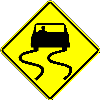Global Navigation

Main Navigation
Sub-Navigation

Content
We can also restrict the rear wheel's rotation by another means. Rolling off the throttle causes the engine to restrict the rear wheel's movement just like applying the rear brake. If we restrict the rotation of the belt, chain or shaft by reducing the speed of the engine, because it is connected directly to the rear wheel (assuming the clutch is not squeezed) the rotation of the rear wheel is also restricted. So rolling off the throttle has the same effect on traction as rear wheel braking. And braking force is another user of our traction.
Downshifting has a more significant impact on the rear wheel. Unless the clutch is eased out very slowly, the call for braking force is much greater than with rolling off the throttle.
The third user of traction – Cornering
The third and final user of traction we need to understand is cornering. Whether we are turning a corner out of our drive and onto the street or gliding through a sweeping curve in the countryside, we want our bike to go in the direction we desire. After all, few roads from here to there are perfectly straight, so turning is important to reaching our destination.
To turn our motorcycle, we know we must cause the bike to lean. And we know that the faster we go through a curve, the more lean that is required to negotiate it. We also know that a tighter turn requires more lean than a gentle turn. When we press on the handgrip to introduce lean we expect our motorcycle to go around the corner. As our bike leans through the turn, it is the friction between our tires and the road surface that keeps us from sliding off the road. The more we lean our scoot, the more friction required to hold us on the road. This is known as cornering force, the third user of traction.
Sidebar
Footer
Copyright 1996-2015 Chuck Miles All Rights Reserved
All information on this site, including all articles, are copyrighted materials belonging to Chuck Miles.
Design: Made in Austria | Author: G. Wolfgang



